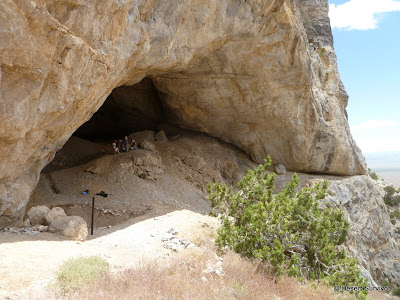The kids were quite excited about the creek fording. Most of the year Smith Creek by the canyon mouth is dry, but it's running now due to spring (and summer) runoff. After we crossed the creek, we drove along the road until we found what we thought was the closest place to hike to the cave. There's no trail, so we were off on a wild adventure.
We started off about 10 am, and it was already quite warm by then. First we had to trek through a long slope covered in thick cheatgrass.
I had Desert Girl in the backpack, so I was really appreciative of Andrea and her husband, Kevin, who helped Desert Boy quite a bit.
Especially when we got to this rock climbing section! There's a scrambling route around it, but Desert Boy's friend, just a year older than him, is a great climber and was up it in a flash.
Andrea and her daughter, with the valley bottom already far in the distance.
We had to take several breaks, trying to find a little shade next to the juniper trees. Desert Girl got a little crabby, so I had to feed her snacks the whole way up. Finally we made it.
The entrance was much larger than it had looked from below. The main room of the cave goes back in quite a ways, and we liked the shade and cooler temperatures.
After a snack break, we started exploring. There are several pits in the cave, as the cave has been the subject of paleontological and archeological surveys.
Here's what paleontologist Timothy Heaton has to say about Smith Creek Cave:
"New species of mountain goat (Stock 1936), eagle (Howard 1935), and gigantic vulture (Howard 1952) were described from Smith Creek Cave, the primary site. Literature on the Smith Creek Canyon sites includes a description of the avifauna by Howard (1952), the micromammalian fauna by Goodrich (1965), the herpetofauna by Brattstrom (1976), the whole fossil assemblage by Miller (1979) and Mead et al. (1982), and the archaeology by Bryan (1979), Harrington (1934), and others."
Wow, this cave may be a pain in the butt to get to, but it sure has revealed some really neat things! The mountain goat was named Harrington's Mountain Goat, and was smaller than today's mountain goat, with a narrower face and thinner horns. It existed for at least 19,000 years, before disappearing about 11,000 B.C.
The gigantic vulture may have been the largest North American bird capable of flight, with a wingspan of 16-17 feet (5 m)! It was originally named Teratornis incredibilis, but later the name changed (as so many do!) and is now known as Aiolornis incredibilis.
The archeological excavations of the cave showed that the cave was reoccupied periodically between 12,000 and 10,000 B.C., which is considered the Paleo-Indian period. This is when Lake Bonneville inundated parts of Snake Valley, huge animals lived in the area, and the vegetation distribution differed significantly from today. The excavations completed in 1968, 1971, and 1974 showed that the users of the cave hunted mountain sheep, other artiodacctyls (hoofed animals), buffalo, and a small camelid. In the cave, they processed hides (Bryan 1977).
I had a vague recollection of a cave map and that there was a passage that went back in a ways. Kevin graciously volunteered to stay with Emma in the big room while Andrea and I took the older kids back farther into the cave.
It was nice to get out to some fresh air. I tiptoed to the edge to see if there was a way back down to the main entrance so we wouldn't have to go back through all the dust, but it was a steep drop off.
The kids were all good sports, eager to explore.
One of the surprises at the upper entrance was a sizable amount of nailhead spar. This calcite crystal made some beautiful patterns. Some of the spar had fallen off and looked like big dinosaur teeth. That was amusing to at least one of the little cavers.
The kids spotted another passageway, so we went down it, hoping again that it might be a way to avoid the dusty passages. But alas, it dead ended quickly and we had to slither our way back through the dusty passages.
Back in the big room, we enjoyed the great views.
I can only imagine what it was like for the Paleo-Indians to be sitting in the cave, looking out over the valley. They would have seen a lake lapping at the shores, much greener vegetation (none of that reddish cheatgrass that is in the photo above!), and interesting animals occasionally passing into view.
We would have stayed longer, but we were getting hungry, and lunch was down below.
So we said our goodbyes and started down.
Smith Creek Cave isn't a cave I would go to for fun caving, but the paleontological and archeological context make it interesting.
Kevin really helped Desert Boy on the way down.
We had our own little mountain goat!
After we got down, we ate lunch in a little rock shelter just up the road, and then it was time to go get clean.
And what better place to get clean than Gandy Warm Springs!
The kids swam until they had goose bumps.
Desert Girl was leery of the water at first, but before long she was totally immersing herself.
The cool water (about 80 degrees F) felt great.
And the scenery was beautiful. The kids thought this was the best part of the day. Maybe the adults, too. But we especially appreciated the warm springs after the hot hike and dusty cave!










































1 comment:
Too bad we weren't able to tell the kids about the giant vultures as we were exploring those passages!
Post a Comment